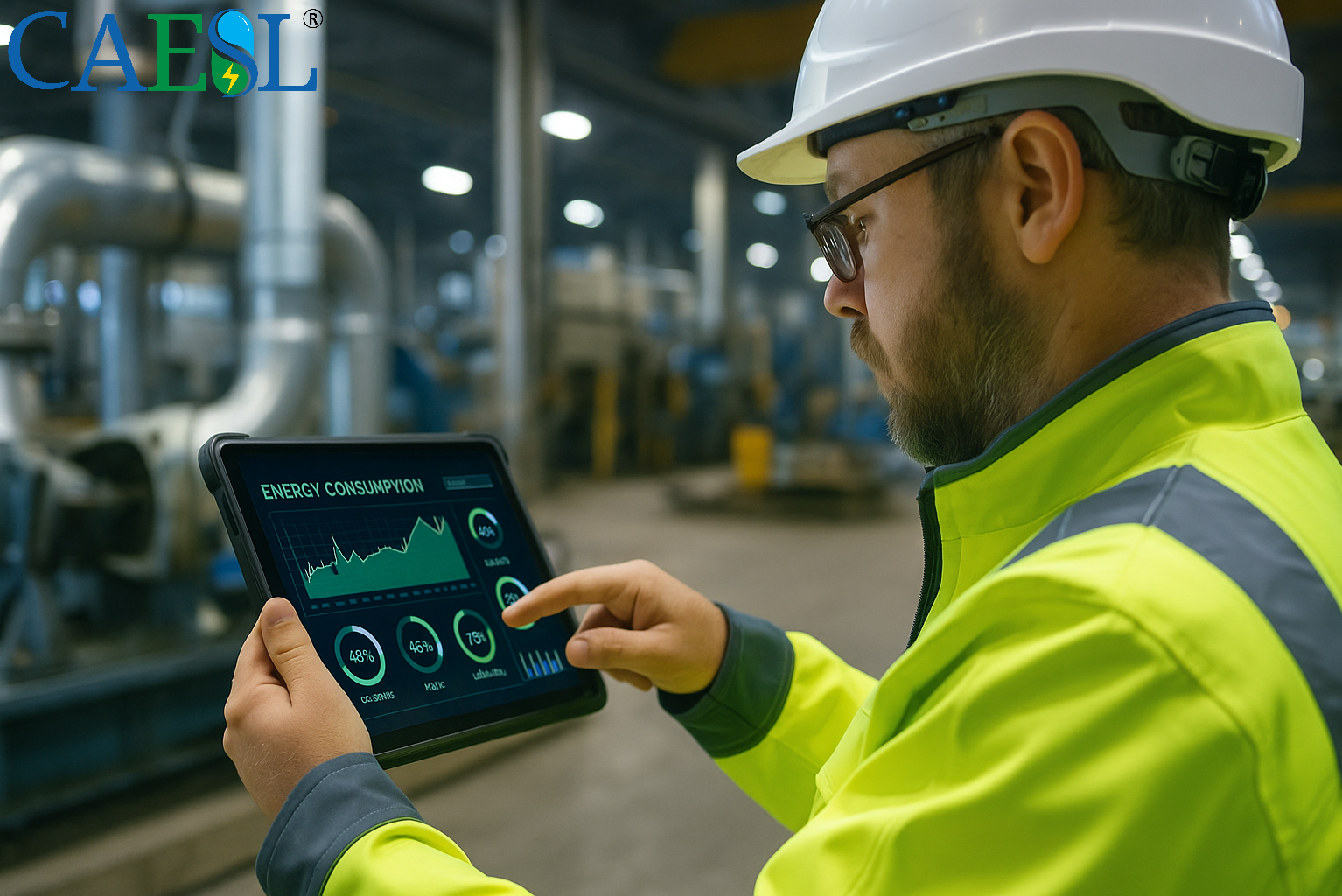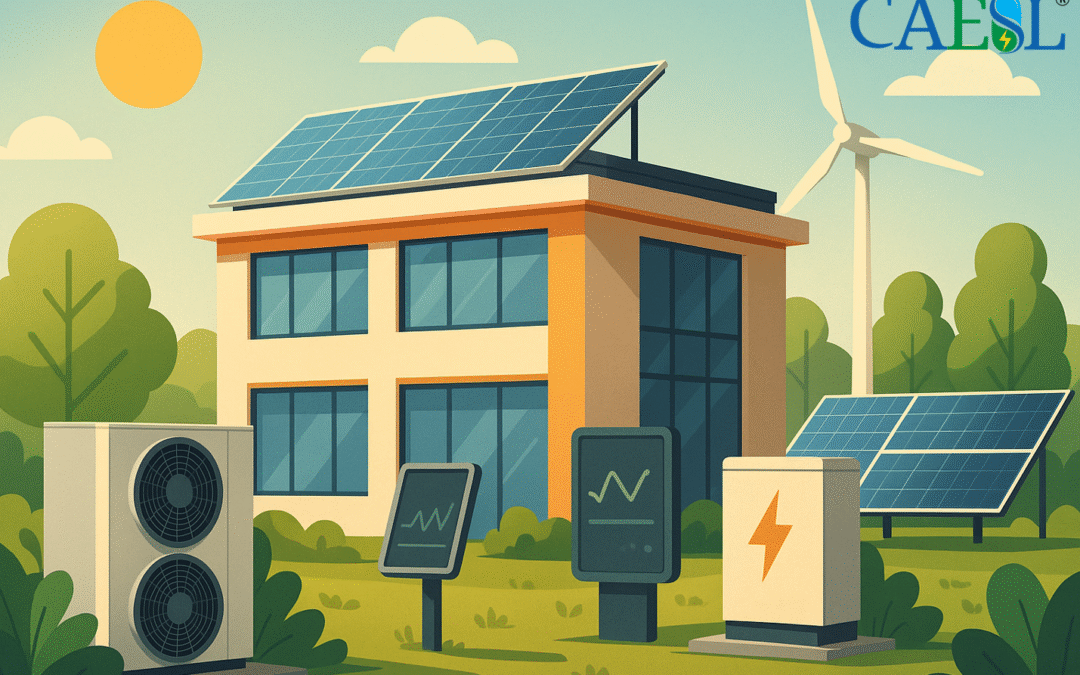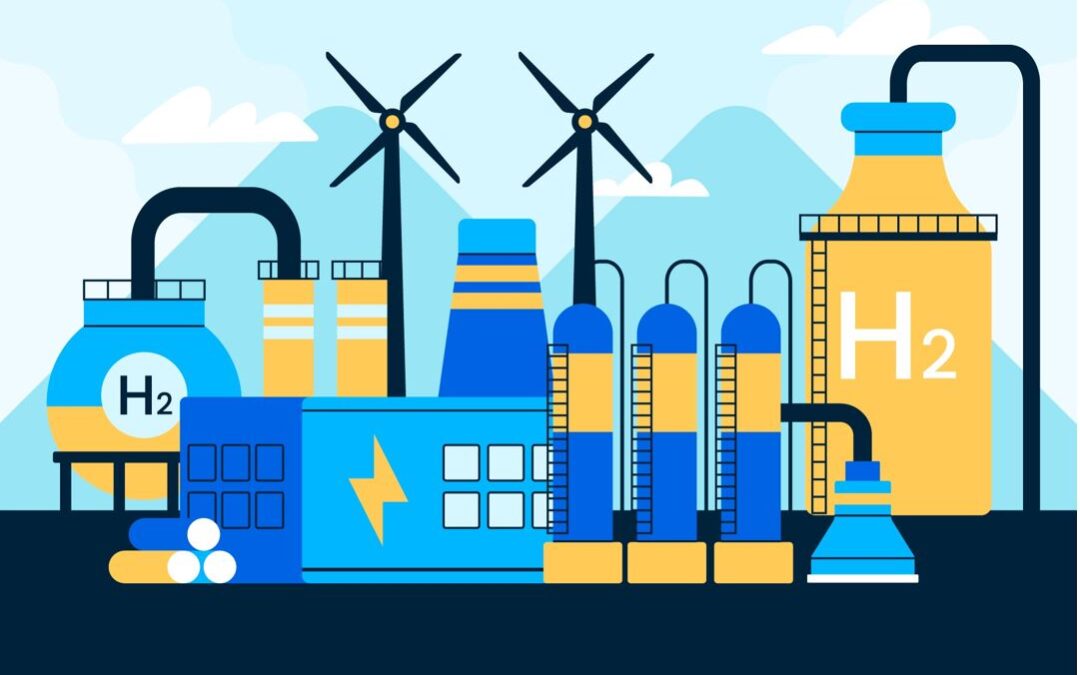In a rapidly shifting global energy landscape, corporations face growing pressures from climate regulations, financial volatility, and environmental responsibilities. CAESL’s latest white paper, developed under the guidance of our Chief R&D Officer, Prof. Hossein Ghadamian, outlines a scientifically grounded strategy to support corporate Net Zero ambitions.
Recent UK reforms—such as the July 2025 CfD extension and Ofgem’s £24bn grid upgrade—signal a national push for clean energy. Simultaneously, international frameworks like the EU Green Deal and UN’s 2030 Agenda demand measurable climate action. This roadmap demonstrates how businesses can integrate ISO 50001 and ISO 50002 standards with cutting-edge technologies to deliver lasting results.
Energy management, driven by systems engineering and thermodynamics, can yield 3–10% yearly efficiency gains. Energy audits offer 10–30% reductions by identifying and fixing inefficiencies. When combined with AI and IoT, these measures can further reduce emissions by up to 20% and lower operational costs through predictive analytics.
Benchmarking and Kaizen-driven continuous improvement are essential components. The approach enables quarterly progress reviews and employee-led innovation. Case studies such as Ford and Saudi Aramco showcase the power of structured energy programmes in achieving substantial cost and carbon savings.
CAESL’s EPC+ methodology combines synchronisation with ESG and ISO frameworks, technical viability, personalised EnMS setups, and advanced technologies like digital twins. Our solutions—including TASHEX and greywater recycling—have already shown potential to cut energy and water use by up to 50% in real-world applications.
The above summary only scratches the surface. Read the full paper below to explore how energy intelligence is transforming sustainability into a long-term business advantage. This article has been prepared by our Postgraduate Engineering Intern, Miss Megha Kabsuri under the supervision of our Chief R&D Officer, Prof Hossein Ghadamian.

Integrating Energy Intelligence: A Scientific and Technical Roadmap for Corporate Net Zero Sustainability
The global energy landscape is undergoing a profound transformation, shaped by elements including climate-induced shortages of resources, rigorous regulatory environments such as the UK’s Environment Act 2021 (requiring limitations on water withdrawal and enhancements to ecological diversity) and the EU’s Green Deal (targeting carbon neutrality by 2050), and financial strains from fluctuating energy costs and demands from investors for ESG adherence. Recent UK updates, such as the July 2025 Contracts for Difference (CfD) reform extending subsidies for wind and solar to 20 years and Ofgem’s £24 billion network upgrade plan (announced July 1, 2025), further accelerate this shift by enhancing clean energy accessibility and grid resilience. These elements push major holding and mega corporations to emphasise sustainable energy approaches, as shown by the increasing uptake of standards like ISO 50001. The motivations encompass reducing operational vulnerabilities, realising cost savings of up to 20% via enhanced efficiency, and enhancing business continuity in the face of supply chain vulnerabilities. Projection suggest that neglecting action might cause substantial financial setbacks—estimated at £50–100 billion yearly in adjustment expenses by 2050 from inefficiencies in energy that worsen climate threats—whereas forward-thinking tactics could produce continuous reductions in energy intensity, contributing to long-term decarbonisation goals, as per the World Economic Forum’s 2025 report on AI’s role in energy transitions. At present, numerous companies have adopted ISO 50000 series guidelines, yet their incorporation is often disjointed, with merely 30-40% making full use of digital instruments for refinement, amid policies like the UK’s Clean Power 2030 mission aiming for 95% clean electricity by 2030. Employing energy intelligence—merging AI, IoT, and analytical data—advantages entities by promoting creativity, cutting GHG emissions by 15-20%, and evolving energy into a key resource for enduring value generation and trust among stakeholders, aligning with initiatives like the British Energy Security Strategy’s push for 24 GW battery storage by 2030.
Defining Energy Management and Energy Auditing
Energy management entails a structured approach to planning, implementing, and monitoring energy operations to maximise effectiveness and minimise excess, as outlined by ISO 50001, which sets up a framework for an Energy Management System (EnMS). From a scientific standpoint, it utilises concepts from systems engineering and thermodynamics to lessen entropy within energy streams, allowing organisations to secure yearly reductions of 3-10% through cycles of continuous improvement, as demonstrated in a 2024 Clean Energy Ministerial case study where ISO 50001 implementation at Watts S.A. yielded US$360,000 in savings from a single project.
Under ISO 50002, energy auditing involves a systematic review of consumption behaviours, pinpointing shortcomings using methods like thermal imaging and analysis of power quality. This method measures prospects for advancement, such as upgrading HVAC setups, and research indicates it can yield energy reductions of 10-30% in industrial environments by tackling heat dissipation and suboptimal equipment performance, with a 2025 study showing 26% energy intensity reductions in ISO-certified firms. Collectively, these methodologies constitute the foundation of sustainable activities, merging insights based on data to synchronise with Net Zero aspirations under policies like the UK’s Spending Review 2025, which allocates funding for clean energy and efficiency upgrades. Recent case studies, such as Ford Motor Company’s 50001 Ready program (2023-2025), illustrate how ISO 50001 updates integrated into energy operating systems led to enhanced management and significant cost savings across manufacturing facilities, while Saudi Aramco’s Hawiyah Gas Plant (2024) achieved renewable energy deployment and efficiency gains through ISO 50001 certification, reducing operational energy use by 15%.
Identifying Hazards or Risks and Outcomes of Neglect
Pinpointing dangers in energy inefficiency demands evaluations of risks that cover susceptibilities to climate, like severe weather affecting supply networks, and functional breakdowns such as equipment failures. Scientific inquiries stress that elevated climate threats link to heightened energy density and erosion of corporate worth, with companies encountering up to 5-10% drops in market assessment from unmanaged exposures, as per BCG’s 2024 report on climate inaction costs.
Outcomes of neglect encompass heightened Green House Gas (GHG) discharges, financial damages from escalating energy expenses (possibly 20-30% increases by 2030), and harm to reputation amid scrutiny over greenwashing claims, exacerbated by volatile bond markets and geopolitical tensions as warned by the UK’s Office for Budget Responsibility (OBR) in July 2025. Investigations caution that without measures for efficiency, corporations might add to the breakdown of ecosystems, with 25% of freshwater assets in jeopardy, resulting in wider societal disparities and adjustment costs surpassing trillions worldwide by 2050, according to the Germanwatch Climate Risk Index 2025. Forward-looking identification through TCFD structures lessens these issues, highlighting the necessity for prompt measures aligned with initiatives like the UN’s 2030 Agenda (SDGs 7 and 13).
Benchmarking in Energy Management: Procedural Steps, Incorporating Kaizen, and Achieving Comprehensive Value Management
Benchmarking within energy management entails contrasting performance indicators with sector norms or competitors to detect discrepancies and propel advancements. Procedurally: (1) Specify crucial indicators, like energy density (kWh per output unit) and carbon discharges per income; (2) Gather information utilising IoT sensors and EnMS applications for precise baseline creation; (3) Contrast with benchmarks from sources such as CDP or industry means, including UK policy targets like 78% emissions reduction by 2035; (4) Examine discrepancies via statistical instruments like regression evaluation to identify shortcomings; (5) Execute focused enhancements, such as retrofitting LEDs or refining processes; (6) Oversee and assess advancement every quarter, refining through PDCA sequences.
This procedure supports total value management by refining resources, decreasing expenses by 15-25%, and improving value for stakeholders via ESG synchronisation, as seen in the UK’s Solar Roadmap (July 2025) promoting rooftop solar for community benefits. Incorporating the Kaizen principle—ongoing, gradual refinement—magnifies benchmarking by encouraging changes led by employees, like routine micro-audits, resulting in lasting efficiency improvements. Contemporary instances include a 2023 scenario in manufacturing where Kaizen use cut energy losses by 12% through adjustments to production lines, according to MDPI research, and Toyota Boshoku’s 2020-2023 environmental leadership case, where Kaizen created continuous improvements in auto parts production, reducing emissions and energy use across facilities. Scientific probes, such as a 2024 IRJET examination on ISO 50002-merged Kaizen, demonstrated 20% performance boosts in electrical setups via improvements in voltage quality, and a 2025 Bio port case study illustrated Kaizen-driven boosts in operational effectiveness, emphasising its function in realising total value through minimising waste under initiatives like the UK’s Green Industry Policies (June 2025).
CAESL’s Pioneering Methodology: Synchronisation, Viability, Personalisation, and Technological Integration
Chamberlains Aqua & Energy Systems Limited (CAESL) utilises a pioneering methodology for energy transformation, stressing synchronisation with ISO guidelines and ESG protocols via its EPC+ service, while aligning with UK policies like the Climate Change Act 2008 and the 2025 National Policy Statements revisions for energy infrastructure. Viability evaluations appraise location-specific energy outlines using thermodynamic modelling and LCA to guarantee practical executions.
Personalisation adapts solutions, like custom EnMS designs for varied subsidiaries, integrating client KPIs. Technologically, CAESL merges AI for anticipatory analytics and IoT for immediate oversight, facilitating 15% cost decreases through machine learning algorithms, as per a 2024 study on AI’s net zero potential. This methodology synchronises with Net Zero roadmaps by utilising digital twins for scenario emulation, assuring expandable, durable tactics compatible with the EU Green Deal’s carbon border adjustments.
Embedding Energy Intelligence as a Forward-Thinking Catalyst for Net Zero Pathways
The integration of AI- and IoT-powered energy intelligence acts as a strategic enabler for decarbonisation roadmaps faitating immediate refinement and anticipatory projections. Scientifically, AI uses in renewable placement can boost effectiveness by 20-30%, diminishing emissions via management of demand-side and grid merging, as highlighted in a 2025 Energy Strategy Reviews paper on AI in energy transitions.
Investigations reveal that AI advances net-zero durability by scrutinising extensive datasets for pattern identification, realising up to 40% energy reductions in supply networks, per Zheng et al. (2024). IoT sensors deliver detailed information on energy streams, backing forward-thinking modifications that synchronise with TCFD risk revelations and hasten decarbonisation routes, supporting UK initiatives like the Clean Energy Superpower mission. This embedding elevates pathway effectiveness, converting reactive adherence into visionary guidance. Recent case studies include Xcel Energy’s 2023-2025 digital net zero drive, using AI for emissions reductions and grid optimisation, and Ericsson-Kiona’s 2023 Nordic project, where connected AI cut heating emissions by 20-30% in residential buildings, demonstrating IoT’s role in demand management.
CAESL’s Offerings and Prospective Vision with Its Innovations
CAESL provides extensive services, encompassing EPC+ for evaluations of energy and water, grey-water recycling setups cutting water usage by 40-80%, and TASHEX—an AI-propelled tool for solar effectiveness funded through crowdfunding in 2025, achieving 100% target with ~80 investors as a milestone project demonstrating market confidence in AI-driven solar optimisation.
Prospective vision imagines expanding these innovations, with AI/IoT progressing to back 24 GW BESS merging by 2030, facilitating 95% clean electricity under the UK’s Clean Power 2030 and Solar Roadmap (July 2025). By 2050, CAESL’s advancements could aid corporate Net Zero, utilising blockchain for eco-friendly procurement and nature-oriented solutions for carbon elimination, nurturing a durable, low-carbon economy aligned with global policies like the UN’s 2030 Agenda. While specific CAESL client projects are not publicly detailed, their EPC+ service has supported general sustainability transformations, such as in built environments where grey-water systems integrated with AI reduced operational costs by up to 50%, as inferred from their 2025 blog on smart water solutions.
A further consideration in future-ready energy systems is the integration of adaptive load management techniques using real-time grid feedback and behavioural analytics. Research has shown that behaviour-responsive controls, powered by AI and supported by distributed ledger technologies (DLT), can optimise distributed energy resources (DERs) in real time, reducing peak load stress by up to 25%. This approach not only stabilises grid operations but also decentralises decision-making, encouraging microgrid autonomy in corporate energy frameworks. A 2025 study by Kumar et al. demonstrated the application of blockchain-integrated AI agents in virtual power plants, improving flexibility indices by 30% while ensuring cybersecurity and transparent auditing. This represents a critical advancement in aligning corporate energy strategies with decentralised, low-carbon transition goals. (Kumar et al., 2025)
Conclusion
To summarise, this pathway for energy intelligence equips corporations to traverse energy obstacles scientifically and technically, from ISO adherence to Net Zero guidance. By tackling threats, adopting benchmarking with Kaizen, and merging sophisticated innovations, organisations can secure long-term operational sustainability and innovation leadership.
CAESL’s methodology exemplifies this, providing instruments for revolutionary influence and a forward-thinking route to environmental guardianship, reinforced by UK policies driving clean energy transitions. Expanding on this, the roadmap not only mitigates immediate risks like energy volatility and regulatory fines but also unlocks long-term opportunities, such as enhanced investor appeal through superior ESG ratings and innovation-led growth in a low-carbon economy. Recent findings indicate that holistic strategies such as these can reinforce business adaptability, reducing GHG emissions by 20-40% over a decade while fostering stakeholder collaboration for broader societal benefits, including equitable access to clean resources. Ultimately, embracing energy intelligence positions companies as leaders in the global sustainability shift, ensuring economic viability amid climate uncertainties and contributing to planetary health for future generations. For organisations ready to embark on this journey, partnering with innovators like CAESL offers the expertise to turn strategic visions into measurable realities.
References
- Basurko, O.C., Gabiña, G., Clemens, F. and Uriondo, Z. (2013), Energy performance of fishing vessels and potential savings. Journal of Cleaner Production, 54, pp.30-40.
- European Commission (2016), A Study on Energy Efficiency in Enterprises: Energy Audits and Energy Management Systems. Luxembourg: Publications Office of the European Union.
- Friedler, E. (2004), Quality of individual domestic greywater streams and its implication for on-site treatment and reuse possibilities. Environmental Technology, 25(9), pp.997-1008.
- Geng, Z., Yang, X., Han, Y. and Zhu, Q. (2017), Energy saving and environmental protection for petrochemical process based on the overall optimization of energy efficiency. Energy, 158, pp.911-920.
- Hossain, M. I., Santhakumar, S., Selvaraj, R. and Islam, M.R. (2023), Increasing Energy Efficiency Based on the Kaizen Approach. Energies, 16(4), p.1930.
- Liu, Y., Zhang, Y. and Wang, X. (2019), Smart water management using IoT and AI: A review. Journal of Cleaner Production, 237, p.117725.
- McKinsey & Company (2023), The economic potential of generative AI: The next productivity frontier. McKinsey Global Institute.
- Petek, J., Glavič, P. and Kostevšek, A. (2016), Comprehensive approach to increase energy efficiency based on versatile industrial practices. Journal of Cleaner Production, 112, pp.2813-2821.
- Raza, A. and Ul-Haq, M.A. (2022), Review on Energy Audit: Benefits, Barriers, and Opportunities. American Journal of Energy and Natural Resources, 1(3), pp.42-50.
- Ren, S., Hao, Y. and Wu, H. (2023), How do climate risks affect corporate energy intensity? Evidence from China. Energy, 303, p.131934.
- Ren, S., Hao, Y. and Wu, H. (2025), Does climate risk shape the energy consumption behavior of firms? Energy Economics, 137, p.107764.
- Rozos, E., Makropoulos, C. and Butler, D. (2016), Design and operation of decentralized greywater recycling systems. Water Resources Management, 30(12), pp.4297-4310.
- United Nations (2015) Transforming our world: The 2030 Agenda for Sustainable Development. New York: UN General Assembly.
- Waterwise (2023) Water Efficiency Strategy for the UK. London: Waterwise.
- World Health Organization (2022), Safe Use of Greywater: Global Best Practices. Geneva: WHO.
- Zhang, L., Zhang, Y., Liang, Y., Dong, J. and Zhao, Y. (2025), Integrating artificial intelligence in energy transition: A comprehensive review. Energy Strategy Reviews, 54, p.101472.
- Zheng, Q., Jiang, J., Kuang, Y. and You, J. (2024), Artificial intelligence potential for net zero sustainability: Current evidence and prospects. Resources, Conservation & Recycling Advances, 21, p.200222.
- Kumar, R., Al-Fuqaha, A., Mehmood, R., and Kiani, S. (2025). Blockchain-AI Synergy for Adaptive Load Management in Virtual Power Plants. Applied Energy, 358, 121912.




